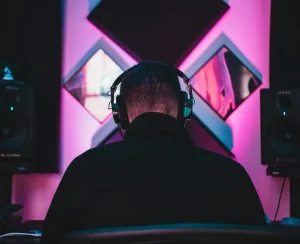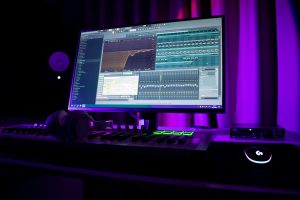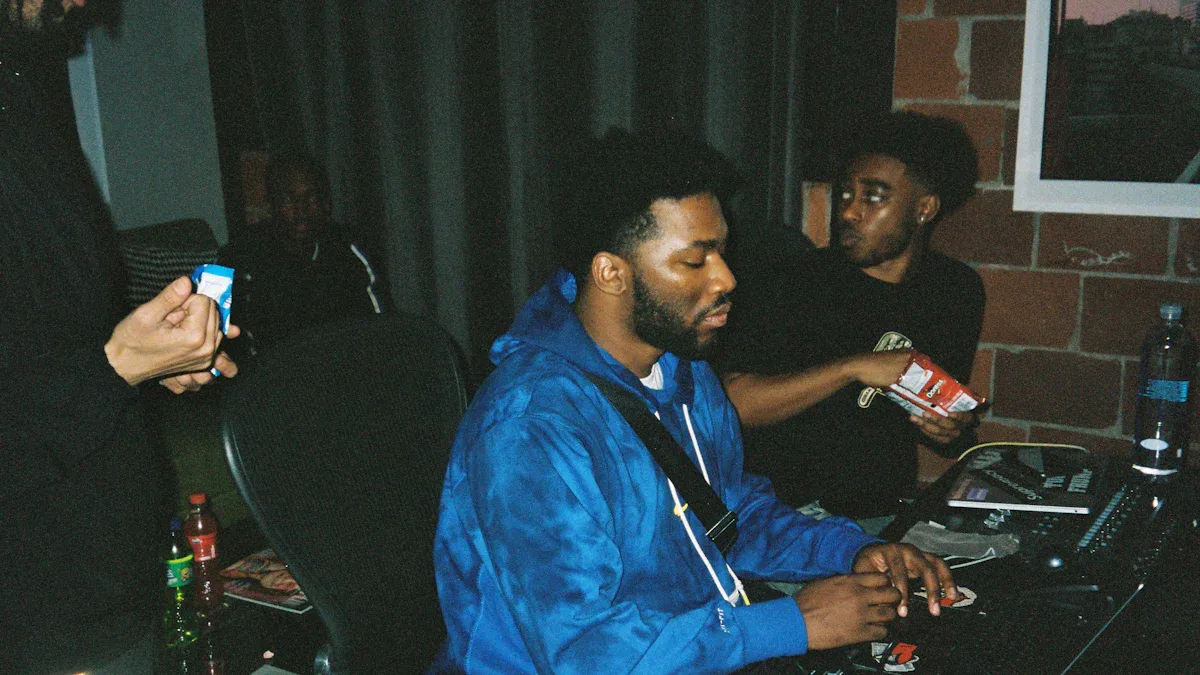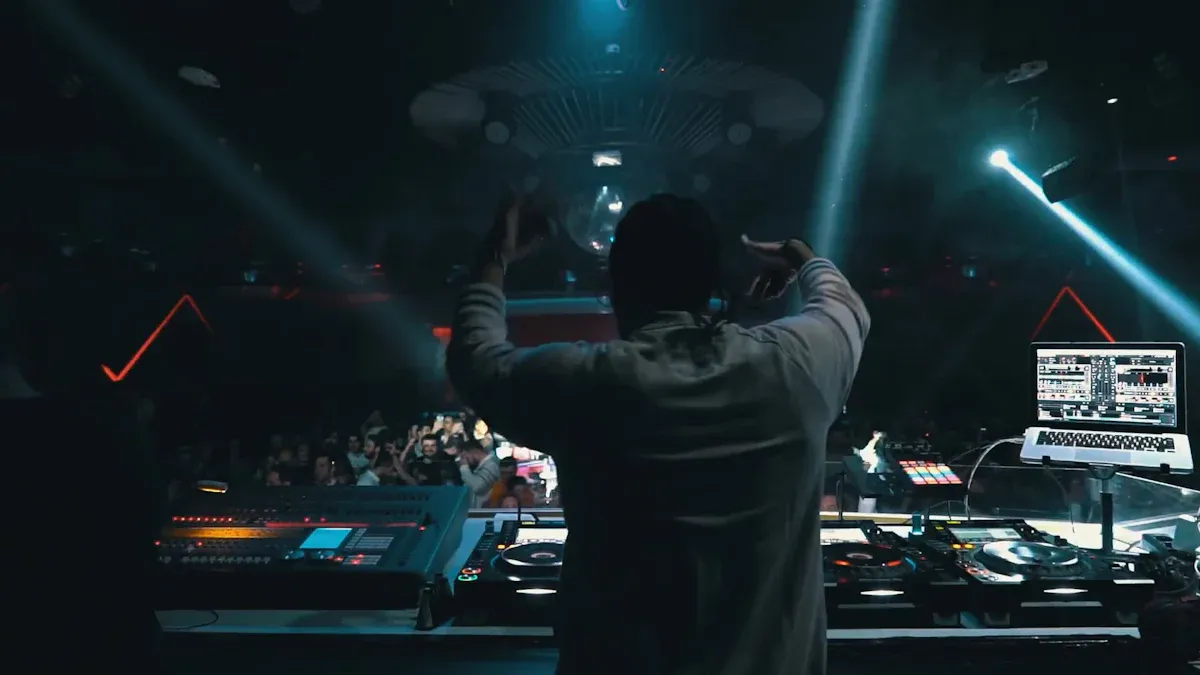Image Source: pexels
Tech House gives you a fresh mix of techno’s punchy beats and house music’s groovy flow. You get a sound that feels both energetic and smooth. This style pulls in huge crowds at clubs and festivals because it makes you want to dance. If you love discovering new music, you might find yourself drawn to the lively Tech House scene.
Key Takeaways
Tech House blends techno’s strong beats with house music’s smooth grooves, creating energetic and danceable tracks.
The genre started in the 1990s in European clubs, mixing cultures and new technology to form a fresh sound.
Tech House features steady basslines, layered percussion, and simple catchy melodies that keep listeners moving.
Famous artists like Jamie Jones and Patrick Topping shaped the scene, while new stars use online platforms to grow.
Fans enjoy live events and online communities, with future trends including AI music, virtual concerts, and global growth.
What is Tech House
Definition
You might wonder what makes Tech House different from other electronic music. Tech House is a subgenre that blends the best parts of techno and house. You get the strong, steady beats and deep basslines from techno. At the same time, you hear the catchy grooves and smooth harmonies from house music. This mix creates a sound that feels both driving and danceable.
The name “Tech House” actually started as a label in record stores. People needed a way to describe tracks that did not fit neatly into either techno or house. Over time, DJs and producers began using the term for their own music. Many early Tech House tracks came from European artists who loved both acid and progressive house. They kept their production style clean and simple, much like Detroit and British techno.
If you look at music studies, you see that Tech House stands out because of its unique audio features. Researchers listened to almost 200 songs from different electronic genres. They found that Tech House has a special mix: steady bass, changing rhythms, and lively mid-range sounds. This sets it apart from pure techno, which usually has less dynamic change and more static sounds.
Here’s a table that shows how Tech House compares to other styles:
| Genre Cluster | Bass (Low Freq) | Rhythm (Mid Freq) | Dynamics | Timbre |
| Techno | Moderate | Moderate | Low | Static |
| House/Tech House | High (Steady) | High (Varied) | High | Moderate |
| Dubstep | Low | Low | Low | Moderate |
You can see that Tech House shares some features with house, but it also keeps the punchy feel of techno.
Appeal
You might ask, “Why do so many people love Tech House?” The answer is simple. This genre makes you want to move. The beats are strong, but the grooves are smooth. You can dance for hours without getting bored. Clubs and festivals often play Tech House because it brings energy to the crowd.
You get the best of both worlds: the drive of techno and the warmth of house.
The music feels fresh, but it also has roots in classic dance sounds.
DJs love Tech House because it fits well with many other styles, making it easy to mix and match tracks.
Many famous artists helped shape Tech House, like Herbert, Terry Lee Brown Jr., and Funk D’Void. Their tracks show how the genre can sound both simple and exciting. Today, you find Tech House everywhere, from underground parties to big festival stages. The style keeps growing because it always feels new and fun.
Origins
1990s Beginnings
You might wonder where Tech House really started. The story takes you back to the early 1990s. During this time, electronic music exploded across Europe and North America. Cities like Berlin, Ibiza, Amsterdam, and Manchester became hotspots for new sounds and wild parties. Berlin, especially after the fall of the Wall, turned into a playground for music lovers. Clubs like Tresor and E-Werk opened their doors to long, experimental nights. DJs played both techno and house, mixing them in ways nobody had heard before.
In Amsterdam, clubs like RoXY and big events such as the Amsterdam Dance Event brought people together from all over the world. The UK joined in with famous clubs like The Haçienda in Manchester and Ministry of Sound in London. Each city added its own twist. Ibiza, with its sunny beaches, helped spread house music to tourists who took the sound home.
You saw artists like Juan Atkins, Jeff Mills, and Carl Cox push techno forward. At the same time, house music grew with help from places like Amsterdam and Manchester. Producers started using new gear, like the Roland TR-909 drum machine, and tried out fresh techniques. This mix of cultures, clubs, and technology set the stage for something new.
Evolution
As the 90s moved on, DJs and producers kept experimenting. They blended the punchy beats of techno with the grooves of house. You could hear this new sound at underground parties and in big clubs. The music felt different—clean, simple, but full of energy.
Over time, people started calling this style Tech House. Early tracks from the 90s still inspire DJs today. Many new artists dig up old records, giving them a fresh spin. The genre keeps growing, always finding new fans and sounds.
Tech House Sound
Image Source: pexels
Beats and Basslines
When you listen to Tech House, the first thing you notice is the steady beat. The bassline often follows a four-on-the-floor pattern, which means you hear a strong kick drum on every beat. This makes it easy for you to dance and feel the rhythm.
Studies show that Tech House tracks use isochronous bass patterns, just like house and deep house.
The bass usually sits in the low-frequency range, around 19 Hz and 60 Hz. These deep sounds give the music its powerful pulse.
A clear, low-frequency beat helps you sync your movements with the music, making it perfect for the dance floor.
If you have ever heard a remix like Daft Punk’s “Harder, Better, Faster, Stronger” (Pete Heller’s Stylus Mix), you can pick out those repeating bass beats. They hit hard and keep you moving.
Percussion and Groove
The groove in Tech House comes from more than just the bass. You get a steady kick drum, but there are also extra sounds layered on top. These can be claps, hi-hats, or even snaps. The percussion creates a loop that repeats, but it never feels boring because of small changes and syncopated accents.
The groove builds through a mix of regular beats and off-beat touches. This balance keeps your attention and makes you want to keep dancing. DJs use technology to add layers and effects, shaping the rhythm and making each track unique.
Tip: Listen for the way the kick drum and percussion work together. You will hear a steady pulse, but also little surprises that make the groove interesting.
Melodic Elements
Tech House does not focus on big melodies, but you still hear catchy hooks and simple riffs. Producers use short, repeated notes or vocal samples to add flavor. These melodic touches sit in the mid-range, filling out the sound without taking over.
You might notice that the melodies often loop, creating a hypnotic effect. Sometimes, a track will add a new sound or change the melody just enough to keep things fresh. This style lets you enjoy the beat and groove, while still having something memorable to hum along to.
Artists
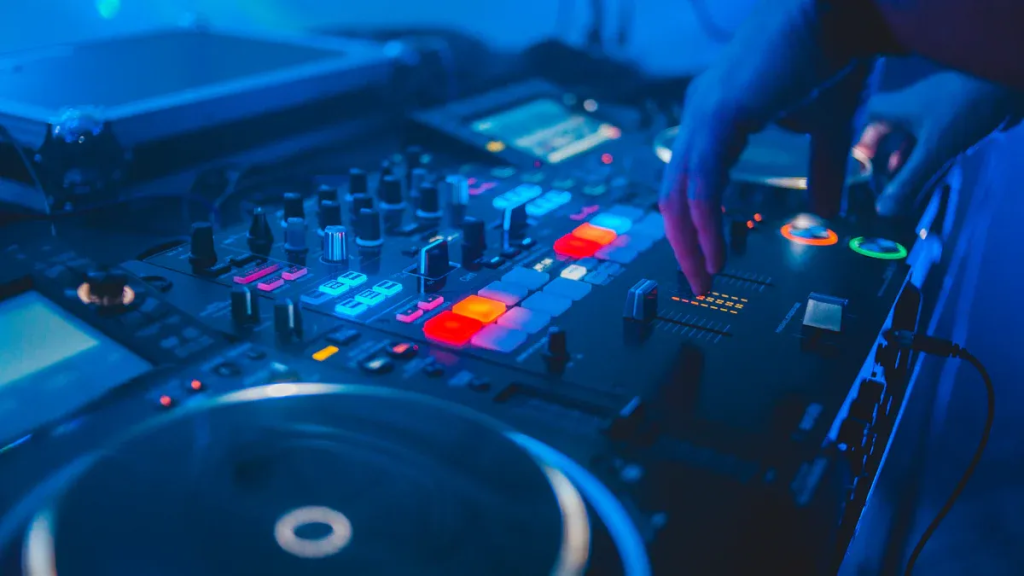
Image Source: unsplash
Pioneers
You might wonder who started it all. In the early days, a few artists shaped the sound and style. Herbert, Terry Lee Brown Jr., and Funk D’Void led the way. They mixed techno’s energy with house’s groove. Their tracks felt fresh and simple, but always made you want to dance. You can hear their influence in many songs today. These pioneers set the stage for everything that followed.
Modern Names
Now, you see new stars taking over clubs and festivals. Patrick Topping stands out. His track “Get Beasty” in 2014 helped him move from a newcomer to a big name. Jamie Jones and Ben Klock also made huge waves. They brought their own twist, making the music even more popular. Labels like Ostgut Ton, Bpitch Control, and Get Physical pushed these artists into the spotlight. You hear their tracks at superclubs in Ibiza and Tulum. Even artists from other genres, like Skream and Solardo, joined in. The scene keeps growing, reaching fans from Buenos Aires to Beijing.
Did you know? The rise of “deep tech” in the UK, led by Mark Radford and his Audio Rehab label, brought even more fans and fresh sounds.
New Generation
You live in a time when new artists can reach the world with just a click. Platforms like Spotify and Bandcamp let them share music and earn money. YouTube helps them show off their skills and connect with fans. TikTok and Instagram make it easy to build a following and go viral. Many young creators use these tools to find their audience. They do not need big labels or radio play. Instead, they use data and direct feedback to grow fast. You see new names pop up every year, each bringing something new to the scene.
Experience
Tracks and Albums
You might want to start your journey by listening to some classic tracks and albums. Many fans recommend starting with singles from artists like Jamie Jones, Patrick Topping, or Green Velvet. Their songs often appear in DJ sets at clubs and festivals. You can also find playlists on streaming platforms that highlight the best tracks from the past and present. Albums are less common in this genre, but some artists release collections that show off their style. Listening to a full album lets you hear how the sound changes from one track to the next. Try exploring different playlists to find what you like best.
Events
Live events bring the music to life. You feel the energy in the room, see the lights, and connect with other fans. Many people say these events shape their love for the music. Recent surveys show that more than half of attendees want to go to even more events this year. Younger fans, especially those between 21 and 35, look for meaningful and transformative experiences. They want smaller, more personal gatherings where they can meet creators and join hands-on activities. Most people go for the music, not just for photos. Many are willing to pay more for events that feel special or use new technology. Social connections matter too. Almost four out of ten say meeting others makes an event unforgettable.
Here’s a quick look at what fans value at live events:
| What Fans Value | Percentage/Insight |
| Want to attend more events | Over 50% |
| Value meaningful experiences | 72% (ages 21-35) |
| Prefer smaller events | 44% |
| Attend for the music | 66% (70% ages 21-35) |
| Will pay more for special events | 79% overall; 78% Gen Z/Millennials |
| Social connection matters | 37% |
| Tech-enhanced events appeal | 76% willing to pay more; 37% feel more positive |
Tip: If you want to meet new friends and enjoy music, try going to a local event or festival. You might find a new favorite artist or track.
Online Communities
You can join the conversation online, too. Many fans gather in forums, social media groups, and chat rooms. These communities help you find new music, share mixes, and ask questions. Healthy online groups grow when new members join and stay active. You see lots of posts, comments, and likes, which means people enjoy sharing and talking. Some groups offer tutorials or Q&A sessions, making it easy to learn. Members often help each other without waiting for a moderator. Surveys and feedback show if the group meets your needs. When you see people coming back often, you know the community is strong.
1. New members join and stay active, showing a lively group.
2. High numbers of posts, comments, and likes mean people love to share.
3. Tutorials, Q&A, and user content keep things interesting.
4. Surveys and feedback help leaders improve the group.
5. Members help each other, building trust and friendship.
6. Many people return often, proving the group’s health.
Note: Joining an online group can help you stay up to date and make friends who love the same music.
Future
Trends
You will see big changes in how people make and enjoy music. Many artists now use smart tools like AI to help create new sounds. Over a third of new electronic tracks in 2023 used AI in some way. This makes it easier for both pros and beginners to make music at home. You might notice more music made with smart DJ controllers and mixing tools. These gadgets help DJs play better shows and try new things.
Streaming keeps growing fast. More people pay for music apps that focus on electronic music. This helps artists reach fans all over the world. You also see more concerts online. Virtual reality and metaverse events let you join a party from your living room. In fact, virtual festival attendance jumped by 40% recently. Artists use blockchain and NFTs to sell music and connect with fans in new ways. Some, like Calvin Harris and The Chainsmokers, already use these tools to earn more and give fans special rewards.
Here are some trends shaping the future:
AI-driven music production is on the rise.
Streaming platforms and subscriptions keep growing.
Virtual and hybrid events are more popular.
Blockchain and NFTs help artists and fans connect.
Smart DJ gear makes live shows more exciting.
Global Reach
You can find this music everywhere now. North America, Europe, and Asia-Pacific lead the way. In Asia, countries like China and India saw a 45% jump in event ticket sales. Streaming and festivals help the music spread to new places. Over 40% of record label budgets now go to electronic music, showing strong support.
Check out this table to see where the music is growing fastest:
| Region | Growth Highlights |
| North America | Strong streaming and festival scene |
| Europe | Leading in digital innovation |
| Asia-Pacific | Fastest event ticket sales growth |
You will see more music in smart homes, too. People play their favorite tracks with just a voice command. Even with challenges like piracy and event rules, the future looks bright. New tech and global fans keep the scene fresh and exciting.
You now know what makes Tech House stand out. The steady beats, catchy grooves, and lively community keep fans coming back. Want to dive in? Start by listening to a playlist or checking out a local event. You can also join an online group to meet other fans.
Tip: Try sharing your favorite track with a friend. You might spark a new love for Tech House!
FAQ
What makes Tech House different from techno or house?
You hear a mix of both worlds. Tech House gives you the punchy beats of techno and the groovy flow of house. The sound feels smooth but energetic. You can dance for hours and never get bored.
Can you listen to Tech House outside of clubs?
Absolutely! You can stream Tech House at home, in your car, or while working out. Many playlists on Spotify and YouTube feature top tracks. The music fits any mood, not just the dance floor.
Who are some must-listen Tech House artists?
You should check out Jamie Jones, Patrick Topping, and Green Velvet. Newer names like Solardo and Fisher also bring fresh sounds. Their tracks often top charts and fill dance floors worldwide.
How do you start making Tech House music?
You can start with a laptop and music software like Ableton Live or FL Studio. Many producers use simple drum machines and synths. Try building a steady beat, then add bass and catchy loops. Practice helps you find your own style.
Is Tech House popular worldwide?
Yes! You find Tech House fans in North America, Europe, and Asia. Festivals and clubs play it everywhere. Streaming makes it easy for you to discover new artists from around the globe.

